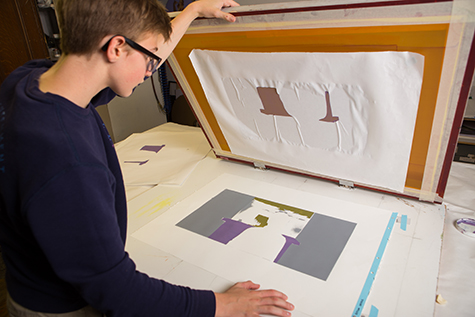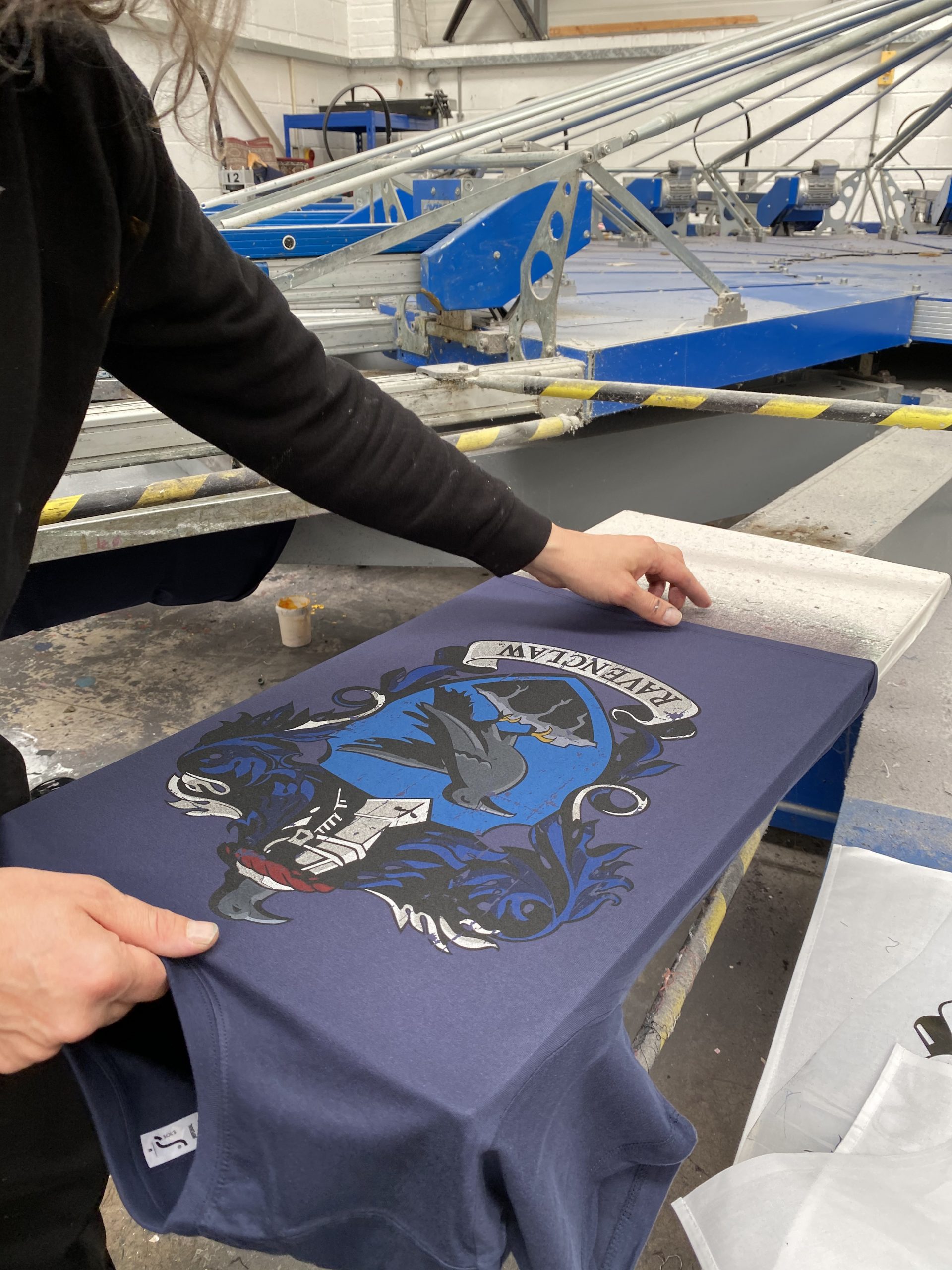Discover the Various Kinds of Screen Printing Techniques for Your Next Job
Screen printing uses a diverse variety of techniques that can improve any imaginative task. From standard approaches like serigraphy to modern advancements such as direct-to-garment printing, each technique has its special benefits. Specialty choices, including metal and green inks, introduce a lot more possibilities. Understanding these methods can considerably influence the final result. However, the challenge hinges on picking one of the most suitable approach for specific needs and preferred effects. What elements should one take into consideration?

The Basics of Screen Printing
Although screen printing may seem complex, it is basically a straightforward procedure that entails transferring ink through a mesh screen onto various surface areas. The method starts with the development of a stencil, which specifies the design to be printed. This stencil is affixed to a mesh screen, generally constructed from polyester or nylon. As soon as the stencil is in place, ink is applied to the screen and pressed via the mesh utilizing a squeegee, leading to the wanted pattern being published on the underlying material.
Screen printing can be performed on a variety of substrates, consisting of textile, plastic, and paper, making it a functional choice for numerous tasks. The procedure enables elaborate layouts and dynamic colors, making it popular in sectors such as advertising, art, and style. Comprehending these basics furnishes people with the foundational knowledge needed to discover more advanced methods in screen printing.
Typical Screen Printing Techniques
Typical screen printing strategies have been utilized for centuries, maintaining the workmanship and creativity of this method. This approach makes use of a mesh screen to transfer ink onto a substrate, such as fabric or paper, permitting for vivid and lasting designs. The procedure begins with creating a pattern, which blocks particular locations of the screen to manage where the ink will be applied.
One popular method is serigraphy, frequently utilized for artistic prints and limited editions. Another is making use of water-based inks, which are environmentally friendly and supply a soft feel on textiles - 10:9 Design Company. In addition, conventional methods can include hands-on printing, where craftsmens use ink with a squeegee, ensuring accuracy and interest to detail
These techniques continue to be valued in the market for their tactile top quality and the distinct textures they produce, attracting both consumers and designers who appreciate the heritage of screen printing.
Digital Screen Printing Innovations
As the need for faster manufacturing and personalization in the printing sector has actually risen, digital screen printing technologies have become a game-changer. This innovation mixes conventional screen printing methods with digital procedures, allowing for fast prototyping and elaborate styles that were formerly hard to achieve. One considerable innovation is the introduction of direct-to-garment (DTG) printing, which helps with high-grade, full-color prints on different textiles without the demand for displays. In addition, innovations in ink formulas have brought about green alternatives that keep vibrant shades while lessening environmental impact. The use of automated systems better enhances manufacturing, reducing labor expenses and enhancing accuracy. These developments not just satisfy little set orders and tailored designs however also permit quicker turn-around times, making them ideal for companies concentrated on meeting consumer needs in a fast-paced market. Digital screen printing, as a result, stands for a vital advancement in the domain name of printing strategies.
Specialized Screen Printing Approaches
Exploring specialized screen printing methods exposes a diverse array of methods that press the limits of creativity and functionality in the printing industry. Among these, glow-in-the-dark inks supply an one-of-a-kind aesthetic impact, making designs come alive in low-light problems. Metallic inks, known for their shimmering surface, include a touch of high-end to printed products. Another cutting-edge approach is discharge printing, which removes dye from the textile rather than adding ink, causing a soft, vintage feel. High-density printing creates an increased texture externally, boosting responsive interaction. In addition, water-based inks are getting popularity for their vivid colors and reduced environmental impact. Each of these specialized techniques deals with certain layout requirements, allowing brands and musicians to produce standout products that reverberate with their audiences. By leveraging these approaches, services can boost their screen printing jobs to brand-new heights, making certain remarkable impressions.
Eco-Friendly Screen Printing Options
Environmentally friendly screen printing alternatives are getting grip as the industry moves towards sustainability. Sustainable ink options and the usage of naturally degradable products are crucial parts in minimizing the environmental effect of the printing procedure. By taking on these methods, screen printers can contribute to a much more sustainable future while preserving top notch outcomes.
Lasting Ink Options

Biodegradable Products Usage
As the screen printing sector progresses, the incorporation of naturally degradable products is becoming progressively important for eco aware practices. Developers and suppliers are now checking out inks and substrates made from all-natural, renewable resources that disintegrate extra efficiently than standard equivalents. These naturally degradable choices decrease plastic waste and lessen ecological effect, straightening with the expanding need for sustainable items.
Common instances include water-based inks and organic cotton textiles, both of which lessen harmful chemicals and advertise eco-friendliness. Brand names that take on these products usually improve their market appeal, attracting consumers that focus on sustainability. As awareness of environmental concerns continues to rise, the shift in the direction of naturally degradable products in screen printing is most likely to acquire momentum, fostering a greener sector requirement.
Selecting the Right Technique for Your Project
How can one identify one of the most suitable screen printing strategy for a certain project? The choice pivots on a number of aspects, consisting of the material to be printed on, the intricacy of the layout, and the preferred production quantity - 10:9 Design Texas. Direct-to-garment printing is ideal for detailed styles with numerous shades, while conventional screen printing succeeds for bigger runs of easier graphics.
In addition, factor to consider of the end-use of the printed product is essential. For outdoor applications, methods that provide resilience and climate resistance, such as plastisol ink, may be preferred. On the other hand, environmentally-conscious tasks might take advantage of water-based inks or biodegradable products.
Eventually, understanding the task's special needs enables for an educated selection, guaranteeing both aesthetic charm and useful long life. By examining layout complexity, product compatibility, and manufacturing scale, one can effectively pick the most proper screen printing technique to satisfy their task's goals.
Frequently Asked Inquiries
What Is the Background of Screen Printing?
Screen printing came from in old China around 1000 AD, progressing with Japan and Europe. By the 20th century, it became popular in business art and style, changing just how designs were created and distributed globally.

Just how Do I Prepare Artwork for Screen Printing?
To prepare art work for screen printing, one must assure high resolution, use a suitable color setting, create different layers for every shade, and transform text to outlines, ensuring compatibility with the printing process and wanted outcome.
What Products Are Best for Screen Printing?
The most effective materials for screen printing include top quality inks, long lasting screens, and ideal substratums like cotton, polyester, or blends. In addition, using proper solution and mops can improve the printing process and outcomes.
Can I Evaluate Publish in the house?
Yes, screen printing in the house is feasible. With the right materials, configuration, and methods, people can produce premium prints. Nonetheless, mindful factor to consider of work area and devices is necessary for effective results.

What Prevail Errors in Screen Printing?
Common blunders in screen printing consist of incorrect exposure times, insufficient ink uniformity, misalignment of displays, inadequate cleansing of materials, and neglecting to evaluate prints. These mistakes can compromise the quality and accuracy of the end product.
Screen printing might appear complex, it is essentially an uncomplicated procedure that entails transferring ink through a mesh screen onto different surfaces. As the demand for faster production and modification in the printing market has surged, digital screen printing innovations have arised as a game-changer. Exploring specialty screen printing methods reveals a diverse array of techniques that press the borders of imagination and capability in the printing market. The ideal materials for screen printing consist of top quality inks, sturdy screens, and appropriate substratums like cotton, polyester, or blends (10:9 Design Company). Typical errors in screen printing consist of inappropriate direct exposure times, poor ink uniformity, misalignment of screens, insufficient cleaning of materials, and neglecting to printable caution signs evaluate prints